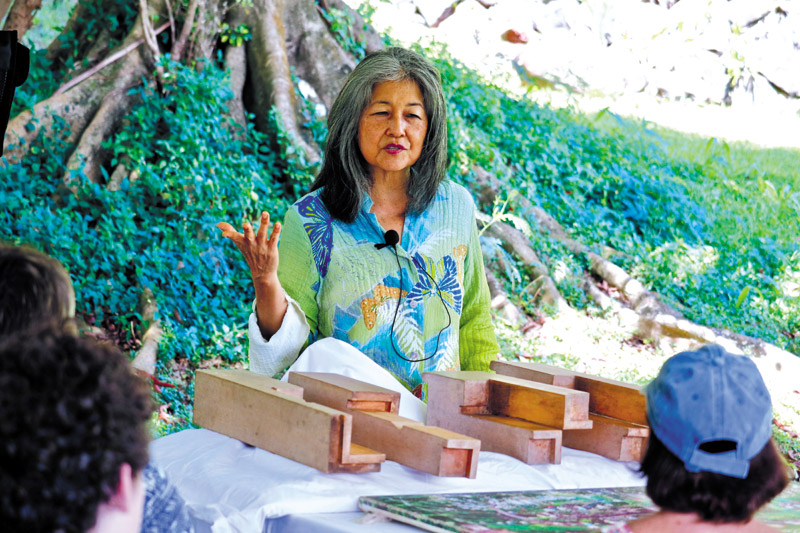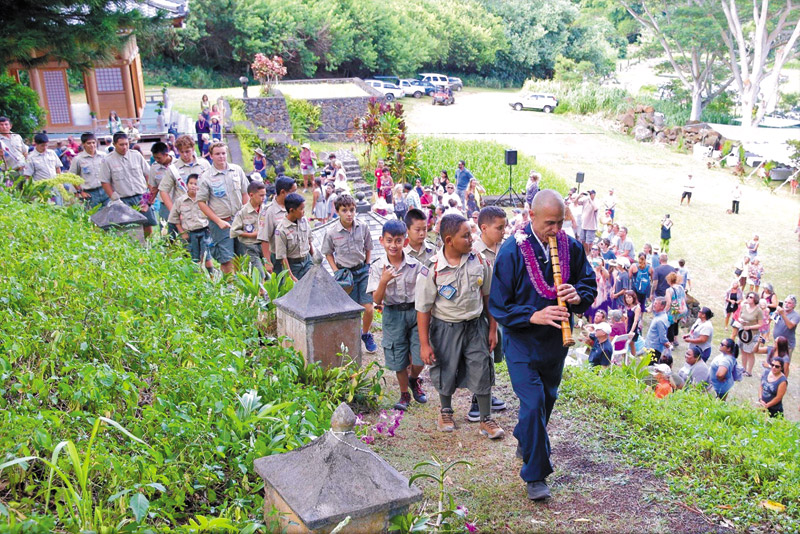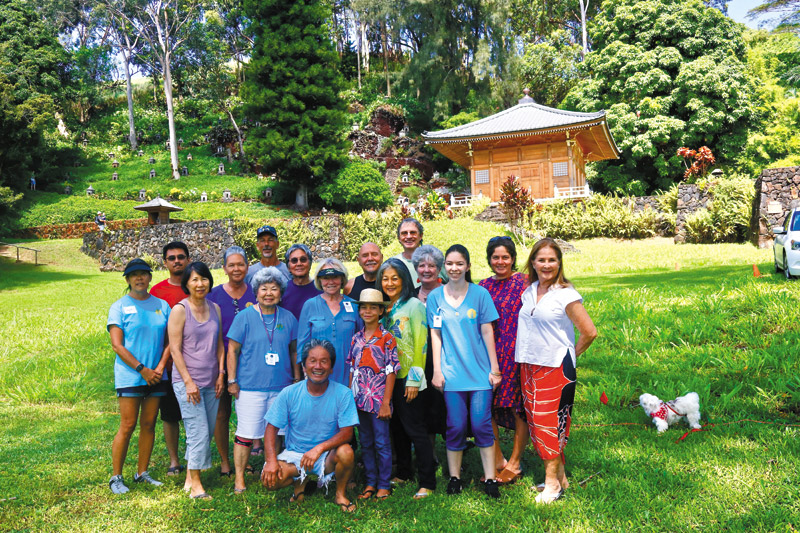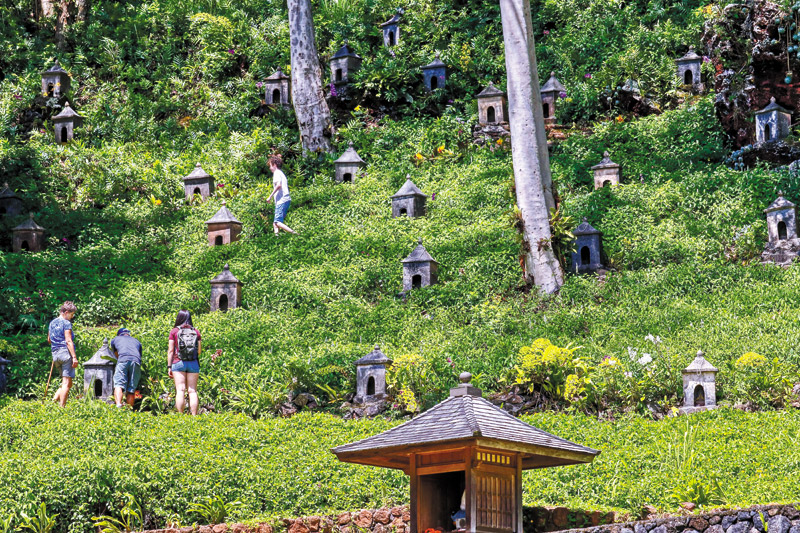A Pilgrim’s Journey
Grandmaster Riley Lee will lead a spiritual procession during LÄwa‘i International Center’s Pilgrimage of Compassion Aug. 25.
On Sunday, Aug. 25, Lāwa‘i International Center will hold its 19th annual Pilgrimage of Compassion. The center’s board president Lynn Muramoto describes the program as a celebration of the spiritual vision of Lāwa‘i Valley, which is recognized as a healing sanctuary.
It was not that long ago — 1990, in fact — when those 32 acres in the heart of Lāwa‘i Valley were overgrown and unmanageable. Muramoto describes it as “a forgotten place.” What few people realized at the time was that beneath the jungle-like setting, there stood 88 miniature shrines, which were built in 1904 by Japanese immigrants.
Even before that, Native Hawaiians visited the same Lāwa‘i lands as a sanctuary.
Over the decades, there was one woman, affectionately known as Grandma Nonaka, who always remembered the importance of this land and regularly made a pilgrimage to Lāwa‘i Valley. Before her sons went to the Korean War and WWII, Grandma Nonaka took a pinch of soil from Lāwa‘i and put it in a pouch to give to each of them as protection. All her sons returned safely.
Over the next 60 years, Grandma Nonaka quietly visited land and offered her gratitude to this special, spiritual place.
“Grandma Nonaka has been the inspiration of the center from the time we met her 29 years ago,” says Muramoto. “She represents the gratitude of our ancestors.”
According to Muramoto, even today, pouches of Lāwa‘i soil have gone to the Middle East and offered comfort for family members as their loved ones traveled overseas.
“Nature has provided places of comfort and they are found all over the world,” she adds. “Lāwa‘i International Center is one of these wonders on the planet, and at the same time, the center is about the people who have opened up the energies of the land.”
To that end, volunteers began clearing away the jungle in 1990. The original land owner wanted $6 million for the 32-acre parcel. So, the group of volunteers sold 28,000 malasadas, 8,000 plates of stew and noodles, and 10,000 bags of mango seeds. Members later negotiated the price down to $250,000.
“Everything is timing, and through the blessings of the heavens, an anonymous donor in 2001 mailed a check to pay for the land,” Muramoto recalls.
Now, nearly three decades later, as one approaches the land they will see the goats, sheep, a donkey and horse grazing along clear pastures.
“They are the volunteer landscape committee for the center,” laughs Muramoto.
Beyond the pastures and along the hillside sits the Hall of Compassion. The hand-carved structure is true to its 13th century architecture and similar buildings have been known to remain standing for 1,000 years. Over 1,600 volunteers and supporters pulled together to create this symbol of the community’s spirit of giving.
“The center encompasses the deep roots of the ancestors and the heartfelt commitment of an entire community,” Muramoto adds. “It is important that the center continues into the future for as it moves forward, the center shifts all those before them and all those after them with compassion.”

Lynn Muramoto of LÄwa‘i International Center’s board explains no-nail jointing construction, which was used to created temple on the center’s grounds.
The first Pilgrimage of Compassion was originally designed as an open house day to celebrate the creation of the center. Volunteers planned the celebration and then, simultaneously in New York City, Sept. 11, 2001, happened.
The open house event was changed to a Pilgrimage of Compassion. Thus the first Pilgrimage of Compassion was underway and as Muramoto says, “everything is timing.”
The volunteer committee wanted the music of a bamboo flute for the pilgrimage, yet they could not find a flute player on Kaua‘i. Muramoto planned on playing grand-master Riley Lee’s CDs, but then she found out that Lee would be on Kaua‘i the same weekend as the pilgrimage. Lāwa‘i Center volunteers contacted Lee, asking him to accompany the people as they walked the path.
Lee graciously agreed and has continued to perform his music every year.
Lee is the first non-Japanese to attain the title of grandmaster outside of Japan. His grandmaster designation did not come easily. He attained the rank 48 years ago after rigorous training that included practicing barefoot in the snow, blowing his flute while standing under a waterfall, and playing in blizzards till icicles formed on his flute.
On the day of the pilgrimage, participants will be able to hear the soothing sounds of Lee’s flute from the top of the hillside for more than 1,000 feet. To celebrate the spirit of the day, students from Kawaikini Public Charter School will dance and members of Taiko Kaua‘i will add their pulsating drumbeats. There will also be a bonsai exhibit, lei-making, fish and tapa printing, mochi pounding, a silent auction and bake sale, as well as cultural and culinary demonstrations.
Lāwa‘i International Center is a nonprofit, nondenominational organization. It is driven by its volunteers, with a goal to bring the valley back to prominence as an international center of compassion, education and cultural understanding of all people.
According to Muramoto, the center is currently working on plans to create a building to replace a tent to provide shelter from the weather.
She hopes that, “this much-needed facility also lays the foundation for future generations to graciously continue to nurture the center.”
The Pilgrimage of Compassion takes place from 1 to 4:30 p.m. Aug. 25. The program begins at 2:30 p.m. For more information visit lawaicenter.org.








